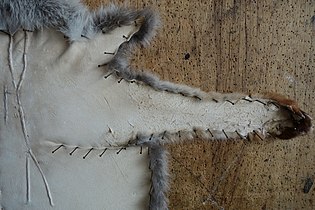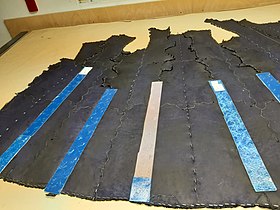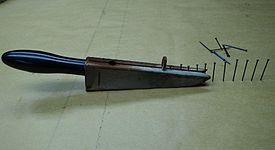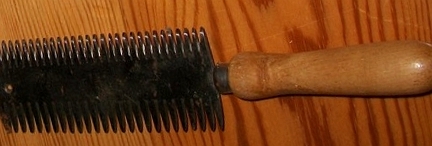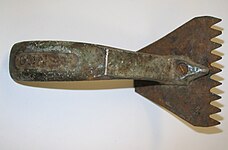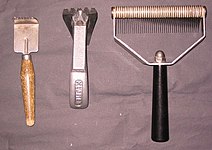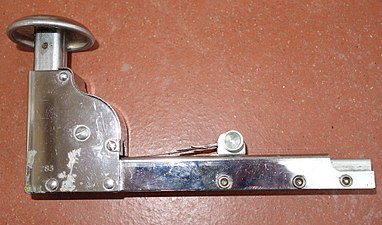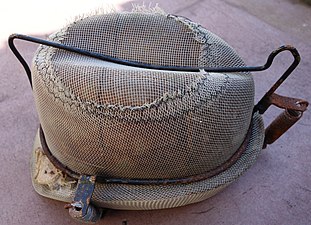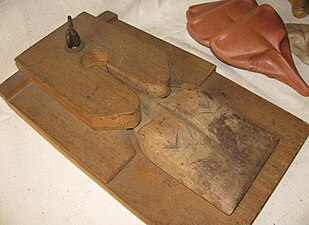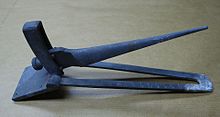Purposes
The purpose or stretching is an essential step in fur production . It describes the unclamping and tensioning of moistened skins or fur parts during the production process. This is usually done by pneumatic stapling or nailing by hand onto wooden boards (purpose boards).
The term is derived from the word “purpose”, which meant something like a nail made of wood or iron, the kürschner term “purpose nail ” represents an actually unnecessary repetition of meaning ( tautology ).
In contrast to tanned leather, the trimmed hide remains more or less elastic due to its leather structure, similar to the raw hide, depending on the type of dressing and the type of hide . The fur surface can be enlarged by stretching, especially when it is damp, and at the same time changed to a different shape. The purpose prevents the fur from contracting again while drying.
Every skin to be processed has to be brought into a shape specified by the product. It may be a part of a larger shape given by a pattern. A collar or muff can be made from just one fur, and even a complete coat can be made from horse skin . For larger pelts and for small pelts, several skins are joined together to form a larger area with the fur sewing machine or with hand seams according to the pattern . This happens after they have previously been appropriately stretched or stretched (aimed) and cut to size. In doing so, and when repairing ( opening ) the skins, numerous seam beads, folds and other unevenness arise, which are removed by smoothing them out during the subsequent purposes.
history
An engraving from around 1830 shows a furrier nailing a hide onto a rectangular wooden frame before further processing. North American Indians and trappers proceed in a similar way, stretching freshly stripped beaver pelts into an oval frame made of flexible branches. However, the fur is held in place by threads or tendons instead of nails. Both variants have the advantage that the skins dry faster due to the air flow on both sides.
Before it was possible to made of wooden sticks and veneer core plywood manufacture, passed end plates even from glued in the groove, well planed pine boards "with oak, inserted best cleats". They were correspondingly heavy in the size of the jacket body and could only be turned and set up to dry with great effort.
The use of a hammer to drive in the purpose nails instead of the purpose forceps was apparently still in use in 1911. At that time there was already aids for pulling out nails. In a textbook for furriers it is said: “Here you can pinpoint what happens with the nail crack of the hammer, with the pliers or with the so-called purpose comb, a comb-like instrument with a handle, in which the prongs are cut very strongly and only very briefly ".
About China, which has a very old, but not yet further developed furring tradition, it was said in 1904: "The hand tools used in furring are very primitive and are limited to a knife in the form of a semicircle, and pliers and special nails".
Especially in the USA, where the work processes of skinning are mainly carried out by semi-skilled workers, during the 20th century at least the purpose was separate for the (fur) tailors, fur sewers, stretchers, finishers and ironers Successful work in a particularly important occupation.
application
In almost every fur production, in which the hair and not the leather of the fur is on the outside of the finished product, one of the operations is the purpose. It ensures that the leather is smooth without wrinkles and that the fur is used to the full.
The situation is different with furs that are worn with the leather on the outside, velvet or napped jackets and coats. Their skins usually receive a leather treatment comparable to that of tanning and have very little or no quick leather. Since hides lose their change in shape when they are wet and also shrink back to their original size, even when the leather comes into contact with rain, a purpose is out of the question here anyway.
Operations
In most cases, the fur is tipped against the board with the hair. The view of the fur seams enables more precise work and the fur dries faster. After ticking, the hair is brushed damp in the direction of the hair, possibly also roughened (exception: curly or moiré fur). Delicate skins can be tipped with the hair upwards, or the coat can be lifted up a little after the tipping at the nails or staples. However, modern finishing devices often make this superfluous (hot air steamer, ironing machine, see → Fur cleaning ).
Brush, brush
In order to be able to use a fur or a larger part made up of fur, it is first slightly moistened with a brush, a damp cloth or with a spray bottle, folded with the leather side and left for a while so that the moisture penetrates the leather completely ( Let it “fatten”; the Austrians say “wash up” when moistening it slightly). The hair should be kept as dry as possible. In any case, the leather should not be made too wet, as this may lead to washing out of the tanning process and it then becomes stiff and glassy (“washed out”). The longer the fur fats, the more docile it is when used. Warm water and a special aid available from specialist shops accelerate soaking. In some companies there was a fat box in which the only slightly moistened parts could soak overnight.
At least in the past, it was quite common for the furrier or the seamstress working on him to sit on the coated part in order to accelerate the threading process through body weight and body heat: "This should absolutely not happen with skins with fine or precious hair, because the moisture penetrates the hair, this squeezes and is often difficult to restore ”(1891).
Preliminary purposes
With many types of fur or processing techniques , it is necessary to pre-use the fur before further processing . The structure of the leather causes the hair to condense when the fur is stretched (the area of the fur is reduced); when it is stretched, the hair becomes thinner and the area larger.
In particular, for omission , the skins are regularly pre-cut before cutting to make cutting and sewing easier. This not only smooths them, it also leads to a hardening of the leather, which is exceptionally desirable in this case; the fur is easier to cut and sew without stretching the narrow outlet strips. The stiffening can, if desired, be increased by a final brushing or spraying with a commercially available laundry starch . The skinning or the skinning technique describes a working method of skinning in which the desired skin shape is achieved by lengthening the skin at the expense of the width by means of V- or A-shaped cuts.
Even if the skins in the finished part are to have a certain shape, often trapezoidal or rectangular, they are appropriately prearranged for better material utilization.
- Preliminary purposes
Purposes

Although the purposes may be greatly changed in shape of decorated fur may by stretching, it should be almost too plentiful set at a proper processing neither. This means that the skin area to be used and the shrinkage depending on the type of skin must correspond to the sample area after setting off. Master furrier Fritz Hempe warned in 1932: "The view that one often encounters, that errors in the inexact processing of the skins in terms of shape and size compared to the pattern can be eliminated by the following purposes, is to be regarded as reprehensible" .
The shape to be achieved is drawn either with chalk directly on the purpose plate using the cutting pattern or with a pen on strong paper to be attached to the plate, in the case of white or light-colored skins on white tissue paper due to the risk of bleeding of the paper.
In skinning operations, the compressed air staple gun or hand stacker is usually used for the purposes. With high-quality workmanship, fine materials are used with thin pins as before, especially in all surfaces that do not fall off when leveling. The fur is held at the edge with the pliers and tightened. When using purpose pens, holding the skin then changes to the other hand, which is holding a purpose nail or a pin. The fur is fixed by one or two pincer strikes on the pin. When using the purpose gun, the edge is only held with the pliers - or with the hand - and at the same time stapled with the other hand. The distance between the purpose nails or purpose staples results from the consistency of the leather, strong leathers require fewer holding points, the purpose pins can be nailed here at greater distances.
When using composite (“furnished”) fur parts, not only are the torso, sleeves, collar, etc. stretched smooth, but the fur seams are also straightened. The seams of the fur side connections and the mostly darker fur centers ( "grots") are straightened into a straight or rounded shape with purpose pins or purpose clips. You always start with the purpose at the end of the fur and stretch the fur with the hairline if possible so as not to compress the hair. In the case of large furs, where the hairline runs to the hem, the center of the back follows after the hem edge has been tapped, then you work your way through to the front edges (with so-called "overturned" processing, hair stroke upwards, should be from top to bottom with awny fur be worked). In the case of outlet work, this means that the middle of the back is straightened first, and then strip by strip to the front edge, usually all the middle of the fur and the side seams of the fur. This is done either with the help of a metal rail or less precisely with a guide line or by eye. Among other things, it is important to ensure that both halves of the item of clothing are mirror-inverted, that the fur panels are as wide as possible, and that the transverse seams are the same height. At the edges, the purpose pins and the purpose clips should be hammered in as close as possible to the edge to save material.
With single-purpose the opposite of the (out) purpose is called. Particularly thin-haired, thin-leather areas in the fur, or areas where for other reasons no width should be cut out, are plumped into the leather. The surrounding leather is tied in place with cardboard strips and the width is evenly distributed and held down in the remaining voluminous part with purpose pins or purpose clips that are densely distributed over the surface. The width may also be ironed in after drying and held in place by pricking or tying.
Particularly in the case of moiré skins such as broad-tailed, the seams are flattened (“paperboarded”) with cardboard strips that are put on, whereby the hair standing up in the seams lies flat. If, on the other hand, sensitive hair is not to be crushed, the fur should be lifted by pulling it up a little on the nails or purpose clips.
The leather must not be overstretched ("popped out") during use, as otherwise there is a risk that it will shrink again when the finished fur is worn. To make sure this does not happen, at least in the dry state, the parts can after Abzwecken, before cutting ( "matching"), in a Schütteltonne ( Läutertonne shake soft). Particular caution should be exercised in skins, which when stretched to Schnattenbildung tend ( "grain crack"), which is the tearing of the skin epidermis (for example Breitschwanz , Indian lamb , Bueno Lamb and others). Instead of rubbing with the seam roller, tapping the seams with a wooden mallet before the drying process is suggested.
- Purposes
Over each other
Many fashionable sewing patterns make it necessary, because of bells or folds, that inserted widths have to be aimed one above the other. If possible, the necessary incisions are made in existing seams, otherwise the skin is cut at this point. The underside is pinned in place with thumbtacks or a stapler. The overlapping part is recorded on the basis of the cutting pattern, possibly on a strip of paper stapled in between, and then used accordingly. An alternative is to transform or shape it.
Um- or shaping purposes
While the tailor needs seams to achieve the Fasson - the bespoke tailor can achieve smaller changes in shape by ironing - the fur processor has the option of achieving this seamlessly with so-called Um- or Fasson purposes . This work, which takes a little longer, especially in the workflow, is used for flat-haired or short-haired types of fur where the seams on the side of the hair would mark ugly. However, if the fur consists of very small skins, darts and overlaps of the pattern can usually be relocated to the existing seams by minimal shifting, thus making repurposing unnecessary. The shaping purpose enables the seamless development of waist darts, bulges, etc. in large and small parts.
In the case of the smaller skins, it is primarily the species of lamb known as broadtail ( Persian broadtail , Indian broadtail and others) that are suitable for use. Due to the already existing skin connection seams, any shape can be prepared here before the purpose, without creating additional seams. In the case of large skins, the speed of the hide leather limits the possibility of removing or pushing in width for purposes (seal skin, flat foal skins).
To repurpose means, in short, to poke a piece open several times to give it the desired shape. The work can be done in two different directions, lengthways or crossways. In the case of waist darts, priority should be given to repositioning in the longitudinal direction, as the back and hip curves can be worked out accordingly. The work process, for example for the back of a coat or jacket, is:
- The set-up back section is first stretched smoothly according to the pattern, with the existing width being distributed around the waist.
- Next, the back of the pattern is drawn onto the dried, scoured fur. The waist length "taper" is tied off with a narrow textile band so that the leather cannot expand during the next use.
- The side parts are recorded side by side on the purpose-built document. Along the banded line, the special purpose pins, needles that are as fine as possible, are pierced and, after the new pattern edge, initially dry, tapped. It is advisable to enclose a very narrow strip of tough cardboard so that the needle points are not unclean. Then the lateral skin parts are moistened and stretched smooth. If there are several waist seams, the process is repeated accordingly.
dry
The drying of the intended pelts or furs should, if possible, take place without additional accelerators. The damp leather must not be exposed to direct sunlight either, as this can quickly lead to burns. If artificially generated heat is nevertheless used, it must be adapted to the different sensitivity of the individual types of fur . The dry air flow generated by fans should only be moderately warm.
Targeting
First of all, after the intended fur parts have dried, all purpose pins and purpose clips are removed with the exception of those on the outer edges. Purpose nails or pins are pulled out with the hand or the purpose pliers, the free hand holding the edge when pulling out by hand. The special purpose pen is gripped with the thumb and forefinger, pulled out and held with the middle finger. This is repeated as often as the hand can still hold the accumulated nails in order to then expediently convey them directly back into their container. The devices developed for de-nailing, such as purpose slides or combs, are only of limited use, with types of fur with thin and quick leather there is a risk that the edges will be pulled out or even tear. Purpose staples are levered out with the simple tacker or pulled out with the broader purpose rake.
The dried fur leather has a greater strength than the fur that has only been trimmed, called "water hardness". In order to put the fur back into a soft state and to prevent it from shrinking after tying it off, it is rubbed soft after collecting the purpose pins or sweeping away the purpose clips before final tying off. This is done by rubbing with the ball of the hand (risk of injury from broken purpose pins or purpose clips!), By rubbing with the stretched wood or by unrolling a seam roller, if necessary in a combination of all three activities, preferably up and down the direction in which the fur is most common was stretched. Especially in the case of exuberantly worked furs, where hair caught during sewing has worked its way through to the leather side when shaken with the shaking barrel, an oversized eraser available in specialist shops can be used to remove this hair at the same time.
It is also recommended to let the fur part rest for three to four hours after it has been tied off until it has been leveled, as it initially “works” within itself so that it can “withdraw to the maximum of its ability”.
Finishing tools
The tipping of purpose pins can be done without tools by hand or with the purpose pliers, the removal of the purpose clips is done in any case with a hand tool, the tearing off.
Essentially two device methods were used to pull out the purpose nails. The simplest is to pull it out through the use of a handle provided with a purpose comb. It has the disadvantage that the edges can easily be pulled out. The sliding system offers a little more security, in which the tipper presses against the fur leather at the same time as the nail is removed. Most of these tacks are not suitable for the thinner pins.
- Tear-off constructions for purpose nails
The removal of the purpose clips is done either with a serrated rake or, if the skin material allows, more rationally with a wide rake that grips with springy steel plates in the clips. While several purpose clips can also be grasped at the same time with the narrower ripper, for staples that are fully driven into the skin, for example when tipping one on top of the other, simple aids are used in addition to the narrow ripper that only remove one clip at a time.
- Splitter constructions for purpose brackets
Purpose tools, purpose aids
In the early days of skinning, only a hammer was used to aim, later with pliers and nails. Since the 1960s in particular, some essential new auxiliary devices have been created for the furrier, which enable significantly faster work.
Purpose nails, purpose staples
Purpose nails or furrier pens are narrow nails made of hardened steel with a neatly worked point in order to minimize the damage to the fur leather. The purpose nails, which were rarely used after the advent of staplers, were recently available in two versions; due to a lack of sufficient demand, however, they are no longer manufactured in Central Europe. Blued steel nails (35 mm long) were preferred by furriers , but over time, despite their bluing, they could rust and were therefore less suitable for white skins. Silver-colored purpose nails were rust-free, but they did not hold as well in the purpose plate. Thinner-leathers are used with stainless steel pins, which are often available in two strengths in the factories (the stronger, longer ones are 30 mm long and 0.7 mm thick).
“Sawn” steel staples for pneumatic staplers have beveled tips at the ends. Commonly used in the furrier trade are clips with a width of 7 mm and a height of 12 mm.
Purpose pliers
The essential tool of the fur processing of the furrier when working, as well as the milliner when working with the hat block , are the purpose pliers . It is made of steel and is currently available in Germany in three sizes (18.5 cm, 21.5 cm, 24.5 cm) (2017) , the smallest is also known as the "Modistange". The inside of the flattened gripper jaws are grooved to better hold the skin. The outer ends are roughened like fish skin to prevent them from sliding off the nail head. The legs of the pliers are bent outwards on one or both sides; Most models have a finger rest, a bent end of the handle, for a better grip. As with the carpenter's hammer, it can have a notch on one end of a handle for pulling out tight nails. The pliers handles of some designs are coated with plastic.
Purpose pistol, hand tacker
Mechanized nailing aids for skinning came on the market for the first time in 1964. They work according to the same system as, for example, the compressed air nailers for saddlers or decorators. Instead of reusable nails or needles, the skins are held on the purpose plate with the help of hand or spring force, compressed air or an electric tacker with purpose clips. The purpose staples are taller than the normal household staples and are not completely shot into the leather when using compressed air, so that they can be pulled out more easily when tying.
- Purpose tools
Purpose plate, purpose table
The functional boards on which the skins or fur parts are stretched usually consist of glued blockboard made of moderately soft wood, often limba . The purpose nails or purpose staples can best be pulled out of this after drying. They come in different sizes in every skinning workshop. When placed upright, the plates are also used to sort the skins. Nailing them up will make the panels unusable over the years and will have to be replaced.
In addition to the simple wooden panels, there are also functional tables. The purpose plate is rotatably attached here, so that it can be turned more easily in order to continue working on the back. Under the plate, on the bottom of the table, there are infrared heaters and fans with which the drying process can be accelerated. Normally, however, the skins should dry off slowly (overnight) in order to keep the stiffening of the leather as low as possible. In addition to the large functional tables, on the tops of which a generous, not too wide, coat body fits, there are tables with three prism-like, also rotatable, functional plates for smaller fur items such as furs or sleeves.
A special feature is the use on wood fiber insulation boards. A hand tacker with shorter clips is used here. A strong piece of paper is placed on the insulation board, on which the cutting pattern is recorded. The peculiarity of this method is the saving of working time when aiming. To do this, the paper placed in between is lifted off the insulation board and the purpose clips are pushed out by tapping the fur with a brush. Due to the fact that the staples are not held firmly in the soft insulation board, the staples may have to be stapled a little closer than on the wooden board.
- Purpose plates and tables
Muff blocks (muff sticks), hat blocks and collier head shapes
Rounded shapes, such as headgear and muffle , can only be partially reproduced with the help of darts in the flat state. Muff and hat blocks made of wood or wood mass, onto which the fur parts are aimed, enable perfect shaping. For caps and hats with a double or shaped edge, the head and edge are tensioned separately.
For the production of fur necklaces , fur shawls with elaborated heads, special shapes are used for the heads. Cardboard head shapes remain in the necklace, wooden ones are removed after drying and used many times over.
- Muff and hat blocks
Purpose rail
To straighten the seams, rails made of light metal are used. They are usually marked with a centimeter scale, lengths of 100 and 120 centimeters are common.
Purpose wedge
Instead of aiming smaller overlaps, the width can also be achieved by placing a wedge underneath. A wedge made of sturdy cardboard is pushed under the required width and held upright on both sides with cardboard strips on the leather side. This method, which is not very precise and is not regarded as really professional, is mainly used in ready-made series production. In the past, the trade also made reusable metal constructions available for this purpose, and wooden wedges were also used. After setting off the kinks must be ironed.
Purpose aid
The liquid purpose aid, formerly also known as "Kürschnermilch" or "Kürschnerbutter" (the latter actually a fat for fulling the skins), is applied to the leather together with the brushing water before the use. Depending on its composition, it makes the leather smoother and faster and prevents the tanning agents from being activated by the use water and the possible associated decomposition of the aged leather when old, worn furs are remodeled .
Expanded wood, seam rollers, erasers
- Seam roller
The seam roller is, besides rubbing it with the hand, a brush or a cloth, the “most harmless” way of removing the hardness of the water from the purpose of the fur. The risk of tearing the fur in the process is very low. After the thorough soft rolling, the leather can also be rubbed gently with the back of the seam roller. The seam roller consists of a hand-sized block of wood and a rotatable, grooved metal roller held by metal brackets.
- Expanded timber
Particularly strong skins can also be carefully rubbed soft with the wooden stretch wood . On the working side it has a slightly rounded edge, possibly made from an inserted metal strip.
- eraser
The large special erasers, especially intended for rubbing off skinned furs, are also well suited for gently rubbing other types of furs.
Web links
Individual evidence
- ↑ The dictionary of origin . Duden Volume 7, 1963, p. 787, keyword “Purpose”.
- ↑ a b Alexander Tuma: Pelz-Lexikon. Fur and Rough Goods, Volume XXI . Alexander Tuma, Vienna 1951, p. 300, keywords "purposes", "purpose board" .
- ↑ a b Paul Cubaeus, Alexander Tuma: The whole of the skinning . 2nd revised edition. A. Hartleben's Verlag, Leipzig 1911, p. 268 . → Table of contents .
- ↑ Paul Larisch , Josef Schmid: The furrier craft . Volume 2, No. 17 + 18, self-published, Paris, April-May-June 1904, p. 85.
- ↑ Editor Die Pelzwirtschaft : The importance of the Berlin fur industry . The fur industry, trade journal for the tobacco trade. January 1, 1965, p. 70.
- ^ Cyril J. Rosenberg: Furs & Furriery . Sir Isaac Pitman & Sons, London 1927, pp. 59-61 (English). → Book title and table of contents .
- ↑ a b c d e f g h i j Author collective: Der Kürschner. Technical and textbook for the furrier trade. 2nd, revised edition. Vocational training committee of the central association of the furrier trade (ed.), JP Bachem publishing house, Cologne 1956, pp. 56, 69, 72–73. → Book cover and table of contents .
- ↑ a b c Alexander Tuma jun .: The furrier's practice . Julius Springer, Vienna 1928, p. 117-125 . → Table of contents .
- ↑ Paul Cubaeus: The whole of Skinning. Thorough textbook with everything you need to know about merchandise, finishing, dyeing and processing of fur skins . 1st edition. A. Hartleben's, Vienna, Pest, Leipzig 1891, p. 265-268 .
- ↑ a b c d e f collective of authors: tobacco product manufacture and fur manufacture . VEB Fachbuchverlag Leipzig, 1970, pp. 399–404. → Table of contents
- ^ Fritz Hempe: Handbook for furriers . Verlag Kürschner-Zeitung Alexander Duncker, Leipzig 1932, p. 44. → Table of contents .
- ↑ If the author is not stated: From matching to sewing. In: The young furrier. Supplement to All about Fur No. 15, Cologne, August 1951, p. 57.
- ↑ Without an author's name: The purposes. In: The young furrier. Number 8, supplement to All about fur . Cologne November 1950, p. 29.
- ↑ The fur trade. 1964, Rifra Verlag, Berlin, Frankfurt am Main, Leipzig, 1964, p. 88.
- ↑ Alexander Tuma: Pelz-Lexikon. Fur and Rough Goods, Volume XIX . Alexander Tuma, Vienna 1950, p. 102 Keyword “Kürschnerbutter” .







